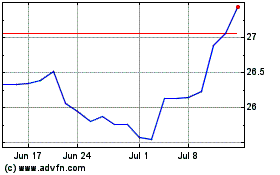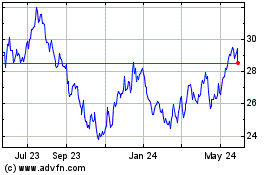Are Investors Abandoning Brazil ETFs? - ETF News And Commentary
09 May 2012 - 8:48PM
Zacks
Although emerging market ETF investing has become more popular
as of late, some countries are having significant trouble retaining
assets. Brazil, for example, was once an investor darling,
attracting not only assets from being a member of the BRIC bloc,
but a significant amount of dollars in its own right as well.
That is because Brazil arguably offers several advantages when
compared to many of the other main emerging market nations.
Geopolitical risks are pretty much non-existent in the South
American sphere while the country is a major—and well
diversified—commodity producer.
This is in stark contrast to the rest of the bloc, all of which
have significant political issues either within their borders or
just beyond their doorsteps. Meanwhile, India and China aren’t
exactly commodity powerhouses while Russia can only boast—albeit
impressive amounts—of natural gas and oil.
Despite these positives, sentiment has begun to change regarding
Brazil. The nation has somewhat of an inflation problem although
rates are in-check even with a lower benchmark rate (read The
Comprehensive Guide to Brazil ETFs).
However, the move to cut the benchmark Selic rate, although it
has jumpstarted the economy, has boosted fears over further credit
expansion to high risk customers. Recent data suggests that
consumer credit default rates are slowly rising while the amount of
both consumer and commercial loans look to rise about 20% this
year.
Given this, there is growing speculation over the quality of
Brazil’s growth, and further questions over how long this can be
maintained. Add in weakened commodity prices across the board and a
bearish case for Brazil can certainly be made in the short term
(see The Seven Biggest International Equity ETFs).
This is further evidenced by ETF outflows from the space as the
most popular Brazil ETF, the iShares MSCI Brazil Index Fund
(EWZ), has seen over $1.4 billion flow out of the fund so
far this year. In fact, among country specific ETFs, this is easily
the worst performance, leaving the next closest country-specific
fund, Hong Kong’s EWH, in the dust by over $1
billion.
However, it should be noted that the rest of the Brazil ETF
category is slightly more positive in terms of asset fund flows.
Only two other funds are seeing year-to-date
outflows—BRAF and BRAQ—while
three are solidly in the green, including a $20 million gain for
the Brazil Small Cap ETF (BRF).
Unfortunately, even these positive moves in asset flows have
been reversed in the second quarter as all the major Brazil ETFs
have seen outflows in this recent time period. In fact, the leader
so far in Q2 for Brazil ETFs in outflows has been BRF, suggesting
that some investors are giving up on all Brazil ETFs, at least in
the short-term (read Brazil Small Cap ETF Showdown).
Who Is Picking Up The Slack?
Instead, some other Latin American ETFs have seen solid inflows
in place of Brazil. The iShares MSCI Chile Index Fund
(ECH) has added about $120 million in assets so far this
year while the Global X FTSE Colombia 20 ETF (GXG)
has put on about $47 million as well.
Even the iShares MSCI Mexico Index Fund (EWW)
has added about $27 million so far this year including a robust
$112.5 million in the second quarter alone. Seemingly, only Peru
joined Brazil in terms of Latin American asset losses so far in
2012.
ETF Performance
Unsurprisingly, the performance of some of the Brazil ETFs has
been lackluster in this asset losing environment. EWZ has added
about 2.1% so far in this year, although some of the small cap and
sector specific funds have added double digits so far in 2012.
However, EWZ is probably the best comparison to other country
specific products and in this realm the Brazil ETF has been handily
beaten so far this year. ECH has added 15.4% so far in 2012, while
GXG has added nearly 27% as well (read Three Overlooked Emerging
Market ETFs).
Clearly, part of the reason for why investors have flowed out of
Brazil ETFs has been to target other nations in the region which
have performed much better this year. These smaller countries
haven’t had the same level of foreign investor interest nor have
they experienced nearly the same level of credit booms.
Due to this, they have been able to avoid some of the excesses
that are currently plaguing the Brazilian economy. Furthermore,
economies like Chile and Colombia have seen better results out of
their main commodities, so there has definitely been a luck
component as well (see more in the Zacks ETF
Center).
Either way, it looks as though in the Latin American ETF world,
the move is decidedly away from Brazil and towards other economies
in the region. Not only have these countries performed better so
far in 2012, but they have also seen more in inflows, suggesting
that their gains may be more durable, especially if more investors
continue to pile into these regional economies.
Want the latest recommendations from Zacks Investment Research?
Today, you can download 7 Best Stocks for the Next 30
Days. Click to get this free report >>
To read this article on Zacks.com click here.
Zacks Investment Research
Want the latest recommendations from Zacks Investment Research?
Today, you can download 7 Best Stocks for the Next 30 Days. Click
to get this free report
iShares MSCI Chile ETF (AMEX:ECH)
Historical Stock Chart
From Dec 2024 to Jan 2025

iShares MSCI Chile ETF (AMEX:ECH)
Historical Stock Chart
From Jan 2024 to Jan 2025
